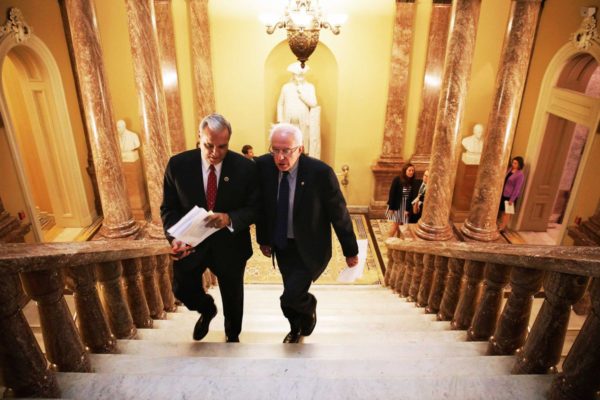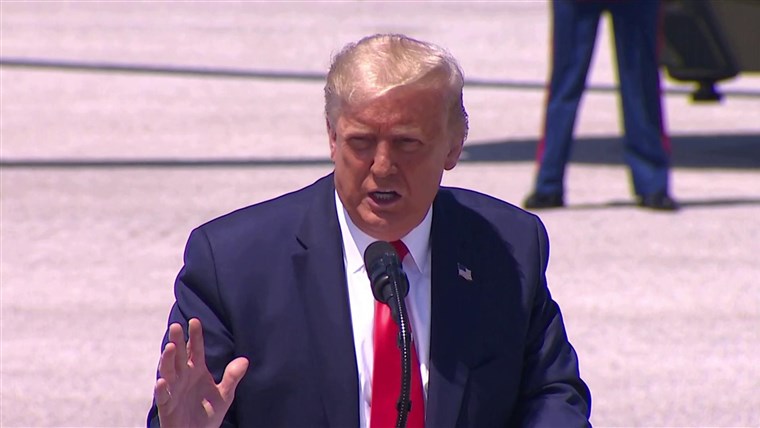
A jogger runs past the U.S. Capitol. Lawmakers and the president still have to agree on a dozen spending bills this fall. (J. David Ake/AP)
Congress is arguing over federal spending again. Here’s why.
The new fiscal year for the federal government starts Oct. 1. Congress and the president reached a big bipartisan spending deal this summer, but they have yet to enact any of the dozen spending bills required to fund government operations.
Neither party right now seems interested in repeating last winter’s historic 35-day partial government shutdown. To keep the federal government open beyond Oct. 1, bipartisan majorities in the House and the Senate have both passed a short-term funding bill to keep the government afloat until just before Thanksgiving. The White House has signaled that the president is likely to sign the stopgap measure into law.
But that’s just a Band-Aid fix. Lawmakers and the president still have to agree on a dozen spending bills this fall that run the gamut from funding the military to protecting the environment, and negotiations will proceed in the shadow of an impeachment inquiry. Here’s what you need to know about these coming battles.
1. You can’t divide a pie until you know how big it’s going to be.
Congress lately has routinely struggled to fund the federal government on the timeline required by the Congressional Budget Act. Last year was a bright spot: President Trump signed five of a dozen spending measures into law before the deadline.
Why is Congress moving so much more slowly this year?
When lawmakers started writing appropriations bills last year, Congress and the president had already set the overall size of the discretionary budget. That gave Congress a head start in divvying up the pie across thousands of federal programs.
This year, the parties did not agree on new spending caps until just before the summer recess. Rather than waiting for the parties to agree on the size of the pie, the House just assumed higher spending limits and started writing individual bills. In contrast, the Senate opted to do little until after Congress had agreed on how big the pie would be. That’s why — just days before the start of the fiscal year next week — the House has passed 10 spending bills that it will probably need to pare back; meanwhile, the Senate hasn’t passed any.
2. The parties face new incentives under a divided government.
Democrats regained control of the House this year. Still, a sizable bloc of Republican lawmakers refused to vote for their party’s bills when they controlled the chamber, either because they favored less federal spending or because they thought the bills weren’t conservative enough. As a result, Democrats retained some leverage over spending bills even when they were in the minority.
[Why are so many Republicans silent about the Ukraine whistleblower scandal? This one chart explains.]
House Democrats face new challenges in the majority. Some rank-and-file Democrats want their party to take more progressive positions in spending negotiations. In April, because of disagreements within the caucus, party leaders canceled a vote in the House on the party’s preferred overall spending levels. And although members of the Congressional Progressive Caucus and the Congressional Hispanic Caucus generally supported last week’s stopgap spending bill to keep the lights on until November, we may see more intraparty conflict over how strongly the party should oppose border wall funding later this fall.
Democrats also need to show voters they can be trusted to govern now that they control one chamber of Congress. When they were in the minority over the past two years, Democrats could accept whatever policy wins they were able to extract and then focus on contrasting their goals with Republicans’ actions. Now, they need to prove they can deliver results.
3. Order matters.
Congress sped up the process last year by combining some of the individual bills into “minibuses,” multi-bill packages that allow different factions get something from each vote. For instance, minibuses last year allowed Congress to pair the defense bill with funding for the departments of Health and Human Services, Education, and Labor. That way, leaders ensured both parties would get their top priorities funded. House Democrats are game to package bills again. But Senate Democrats reportedly want to hold back the Pentagon funding bill so that they can use it as leverage in negotiations over the rest of the spending bills.
[This is why the Congressional budget process is broken]
4. One person’s poison pill is another’s happy pill.
The bipartisan spending deal reached this summer included language that stopped lawmakers from adding new “policy riders” to spending bills this year unless those riders have bipartisan support.
Spending bills often contain riders, which can restrict how agencies spend federal funds. Some riders are politically contentious. Both parties often demand “poison pill” riders as the price for their votes, knowing the rider would be a deal-killer for the other party.
Democrats may introduce controversial riders that would prevent Trump from moving funding to build a barrier along the southwestern border. Last year, Trump’s refusal to sign a bill that did not contain at least $5 billion in wall funding led to a shutdown. He has requested the same amount this year. If Congress refuses to go along, he has threatened to continue to transfer money away from military construction projects to fund construction, as he has been doing this year. House Democrats want to add riders to one or more of the spending bills that would limit such transfers. Republicans, however, argue that the July deal against poison pills protects the president’s ability to move money around.
Democrats want to introduce a number of new riders that Republicans are likely to reject. For instance, they want to add a rider to block the Trump administration from implementing a rule limiting what certain federally funded health-care providers can tell patients about abortion. Riders like these would have been hard sells in a final deal even had the parties not shook hands on a deal to avoid poison pills, but they will still be a source of conflict in coming budget negotiations.
As one House Democrat recently described the overall situation: “Nobody wants a shutdown. But what do you do when you’re so far apart?”
Don’t miss anything! Sign up to get TMC’s smart analysis in your inbox, three days a week.
Molly E. Reynolds (@mollyereynolds) is a senior fellow in governance studies at the Brookings Institution. She is the author of Exceptions to the Rule: The Politics of Filibuster Limitations in the U.S. Senate (Brookings Institution Press, 2017).

